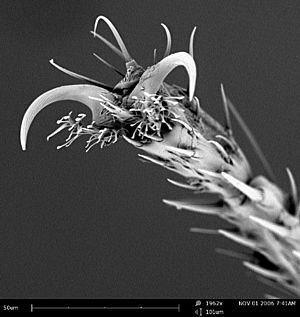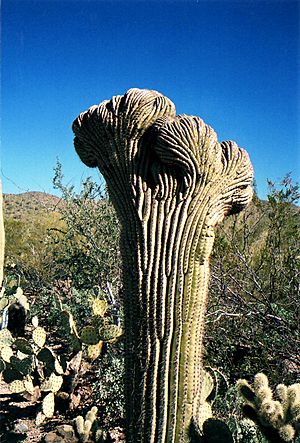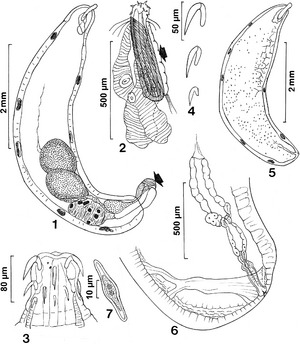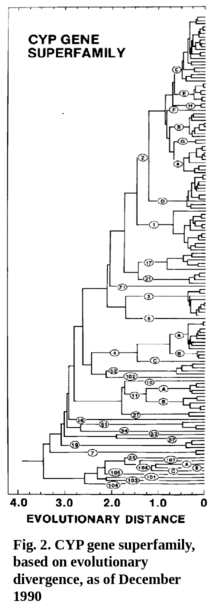Sonoran Desert fly facts for kids
Quick facts for kids Drosophila mettleri |
|
|---|---|
| Scientific classification | |
| Kingdom: | |
| Phylum: | |
| Class: | |
| Order: | |
| Family: | |
| Genus: | |
| Species: |
D. mettleri
|
| Binomial name | |
| Drosophila metlerri |
|
The Drosophila mettleri, also known as the Sonoran Desert fly, is a type of fly found in the Drosophila family. These flies live in North America, especially along the southern coast of California and in Mexico.
D. mettleri flies need specific plants to survive. They mostly depend on saguaro and cardon cacti. This is why they are often found in dry, desert areas. These flies have a special ability: they can get rid of harmful chemicals found in rotting cactus liquid. This allows them to use soil that would be deadly to other insects as a safe place to lay their eggs.
Scientists first found D. mettleri in San Felipe, Baja California, in October 1961. They used bananas to attract different Drosophila species during an experiment. Because of natural barriers like mountains, different groups of Sonoran Desert flies became new species over time. This process is called speciation, and it happens because genes don't mix between isolated groups.
These flies lay their eggs in soil that is wet from rotting cactus liquid. They also use dead parts of cacti. The liquid from rotting cacti gives food to young D. mettleri larvae. Even though this liquid has chemicals that are poisonous to other flies, D. mettleri can handle it. The way these flies find partners, like their special courtship song and mating plugs, helps explain how they choose mates.
Contents
About the Sonoran Desert Fly
How D. mettleri is Different from Other Flies
Among the flies in the Sonoran Desert, D. mettleri is very similar to D. nigrospiracula. They act alike, breed in similar places, and live in the same areas. When scientists collect D. mettleri from cacti, they often find D. nigrospiracula nearby. Both types of flies use the toxic sap from their host plants.
However, D. mettleri has a much better system for getting rid of poisons. This allows it to nest in places that D. nigrospiracula cannot use. D. mettleri likes to lay eggs in soil wet with cactus sap. D. nigrospiracula, on the other hand, lives inside the cactus tissue itself. This means D. nigrospiracula deals with less concentrated toxins.
D. mettleri's amazing ability to handle toxins comes from certain genes. These genes help it resist harmful chemicals, also known as xenobiotics. This special skill lets them use breeding grounds that would kill other young and adult flies.
How They Eat Differently
D. nigrospiracula only feeds on cactus sap directly from the plant's tissues. But adult D. mettleri flies are found on both the cactus and in the nearby soil. This is because they can handle the very strong sap found in the soil. Female flies are more often found in the soil where they breed. Male flies are found in both areas.
What They Look Like
You can tell D. mettleri and D. nigrospiracula apart by their looks. Both flies have large bodies, black colors, and thin, clear cheeks. Their cheeks stand out against their long eyes.
But D. mettleri has some unique features that D. nigrospiracula does not. These include small toe-like parts near their reproductive area. They also have a "v"-shaped part on their head called a frons pollinose. Their gonapophyses (parts of their reproductive organs) are less developed. Also, they only have horns on the front part of their body, not the back.
Where D. mettleri Lives
How Heat Affects Where They Live
These flies are most common in North American deserts. You can find them in Mexico and Arizona. They also live on the southern coast of California, where they use prickly pear cacti.
Of the four Drosophila species in the Sonoran Desert, D. mettleri handles heat the least well. They are common all year, but less so in summer. The rotting cactus tissue in the desert gets very hot. D. mettleri's ability to use the cooler soil near cacti for breeding gives them an advantage. Their young (pupae) have a better chance of surviving than those of other desert Drosophila species. Other Drosophila species are less successful in the desert heat. They cannot burrow into the soil, which harms their young's survival.
D. mettleri has an evolutionary advantage because it can use this special breeding spot. Other Drosophila species can handle more heat because they breed inside the hot cactus tissue. But D. mettleri does not need to handle as much heat. This is because they can use the cooler soil around the cacti.
How Geography Affects Them
The landscape of the Sonoran Desert causes genetic differences among desert Drosophila species. These flies feed on rotting cactus. The Sonoran Desert includes the Baja California Peninsula and mainland California.
After the peninsula formed, the Gulf of California became a barrier. This gulf is between the peninsula and the mainland. It stopped insects and land mammals from spreading easily. Another natural barrier is the Gran Desierto de Altar. This is a large sand dune between the peninsula and the mainland. These barriers affect how genes flow between Sonoran Desert flies.
Studies of genes in D. mettleri and D. nigrospiracula show interesting differences. In D. nigrospiracula, there were genetic differences between flies on the peninsula and those on the mainland. But in D. mettleri, there were no such differences. This suggests that D. mettleri spreads in a "stepping stone hypothesis" way. This means they move from one suitable spot to another, even across barriers.
The closest relatives of D. mettleri do not live in the Sonoran Desert. This means the four Drosophila species in the Sonoran Desert developed similar traits on their own. This is called parallel evolution. It did not happen because they evolved from each other within the desert. The other species native to the Sonoran Desert are D. nigrospiracula, D. mojavensis, and D. melanogaster.
Where D. mettleri Lives and What It Eats
Host Plants
The main plants that D. mettleri uses are the saguaro (Carnegiea gigantea), the cardon (Pachycereus pringlei), and the senita (Lophocereus schottii) cacti.
D. mettleri is most often found in saguaro and cardon cacti. This is partly because these cacti are larger and cooler inside. Also, these cacti release more liquid into the soil. This rich soil becomes a good place for the flies to lay eggs. The rotting parts of these cacti can also be used for feeding and nesting. However, D. mettleri uses these rotting patches less often than other desert Drosophila species.
Choosing a Host Plant
All Sonoran Desert Drosophila species choose specific host cacti. Each fly species uses a different host plant for food and breeding. Choosing the right host cactus is important. It affects how many resources are available to the flies. This also plays a role in their growth and development.
Other Reasons for Host Choice
Each fly species uses rotting patches on the cactus for food. The largest rotting patches are found in cardon, then saguaro, organpipe, and finally senita cacti. The size of the cactus or its arms did not affect the size of the rotting patches. Instead, seasonal changes in how the host plants grew determined the size and number of rotting patches.
Also, how long a rotting patch lasted depended on the time of year. Patches were least common in spring and most common in summer. Other Sonoran Desert Drosophila species showed a link between how rich their host's rotting patches were and their population size. But for D. mettleri, this link was not as clear. D. mettleri uses both rotting patches and the soil near rotting cacti. Also, this species can live on many different hosts. This allows these flies to spread out more in a given area.
The time it takes for larvae to develop and how available host cacti are greatly affects the growth of larvae and how well adults reproduce. For larvae, the best conditions are long-lasting rotting spots. This gives them enough time to grow into larger, healthier adults. For adults, good conditions mean hosts that grow regularly. This gives adults a steady place to lay eggs.
Defense Against Toxins
Host cacti contain toxic chemicals that usually stop flies from eating them. D. mettleri has genes that allow it to break down these toxic compounds. This means they can eat the cacti as a food source. These genes are linked to how they evolved to resist harmful chemicals, known as xenobiotic resistance.
Life Cycle and Reproduction
Laying Eggs
D. mettleri flies are known as necrotrophs. This means they lay their eggs in the rotting parts of dying cacti. Compared to other necrotrophs in the desert, D. mettleri prefers to breed in soil soaked with the liquid from these rotting cacti. They prefer this over breeding directly in the cactus tissues.
This behavior is important because the desert's dry conditions cause cacti to lose a lot of water. The liquid toxins that seep into the nearby soil become very concentrated. Other necrotrophs cannot handle these high toxin levels. So, D. mettleri's ability to detoxify these chemicals allows it to breed in a special environment. This environment is not commonly used by other species.
Scientists have studied D. mettleri's special detoxification abilities. They wanted to see if changing host plants would affect the genes of future generations. They found that future generations showed changes in their genes. These changes helped them break down the different chemicals in their new host cacti.
Mating Behavior
The courtship song of D. mettleri has special vibrating pulses and sounds. If a female fly moves more, the male's vibrating pulses will be more irregular. To start the song, a male will spread his wings seventy to eighty degrees. Then he releases a few short pulses. After this start, the male releases more regular pulses.
Enemies of D. mettleri
Parasites
Drosophila species, including D. mettleri, face threats from ectoparasistic mites. These mites live in the rotting spots on desert cacti. When D. mettleri feeds or breeds in these areas, the mites attach to them. These mites can shorten the flies' lives and make it harder for them to reproduce.
Genetics of D. mettleri
Special Genes for Detoxification
To use the rotting liquid from dying cacti, D. mettleri has developed special changes in its genes. These changes are called mutations. Scientists believe these mutations are why the fly can resist harmful chemicals, known as xenobiotics.
Three groups of genes help insects detoxify poisons: P450s, esterases, and glutathione s-transferases. In D. mettleri flies, a specific gene called CYP28A1 is very active. This increased activity is an adaptive response. It helps the flies deal with toxic alkaloids in their host plants. The more alkaloids a D. mettleri is exposed to, the more active its Cyp 28A1 gene becomes.
The P450 family of genes can change a lot with just a few small mutations. In the Cyp 28A1 gene, a single change from one type of amino acid to another can cause a big difference. This change makes the gene much more active. This leads to a major change in the protein's structure. As a result, D. mettleri can break down more toxins from its host plants.
Genetic Differences Between Species
A new study looked at how genes are separated between two fly species, D. mettleri and D. mojavensis. These flies live on the Catalina Islands off the California coast. On these islands, the flies have started using prickly pear cacti as their host plants. Scientists found genetic differences in these flies.
They compared the genes of these island flies to other flies that also use prickly pear cacti. They found relationships between the genetic patterns of D. mettleri and D. mojavensis. The study concluded that the San Pedro Channel, a body of water between the Catalina Islands, caused genetic separation. Also, environmental factors led to genetic differences in the D. mettleri and D. mojavensis flies that feed on prickly pear on the Catalina Islands.
How D. mettleri Works (Physiology)
Controlling Body Temperature
Different Drosophila species use different types of cacti. The type of cactus D. mettleri usually lives on affects how well it can handle heat. This is true even if the flies live in the same general area.
Larger cacti, like the cardon and saguaro, hold more water. This helps them stay cooler inside when it's very hot. Smaller cacti, like the senita, hold less water. They tend to get hotter in dry climates. D. mettleri is most often found near saguaro and senita cacti. This explains why they have a lower heat tolerance than other desert Drosophila species.
The differences in where species live among host cacti are linked to how well the flies can detoxify toxins. These toxins are naturally found in different cactus species. D. mettleri has genetic changes that help it detoxify the chemicals in the cooler saguaro and cardon cacti. Over time, they needed less to live in hotter cacti. This reduced the genes that helped them handle higher heat.
Working Together (Mutualism)
Using Rotting Cactus Patches
Other desert Drosophila species can also use the saguaro and cardon cacti for food. D. mettleri is one of only two species out of nine that can use the juices of the senita cactus as food.
Alkaloids in cacti are very toxic to most Drosophila and can harm the development of their larva. Chemicals that make desert cacti toxic include certain fatty acids, sterols, and senita alkaloids. Some Drosophila species can survive these chemical conditions when breeding in cacti. But this often reduces the survival of their larvae. D. mettleri is one of two species where the toxicity of the cacti (especially the senita) does not reduce the survival rates of larvae and pupae. It also has little effect on the mother fly's survival.
Choosing a Nesting Spot
D. mettleri has a unique ability to breed successfully in both the rotting tissue of desert cacti and in soil wet with rotting cactus liquid. However, these flies prefer to breed in the soil. The soil conditions are cooler, and there are fewer predators.






